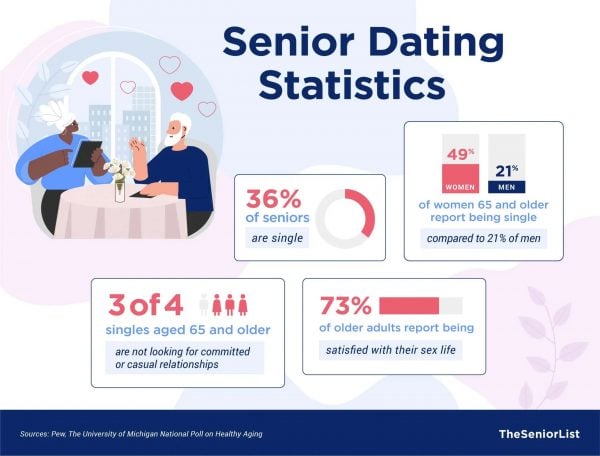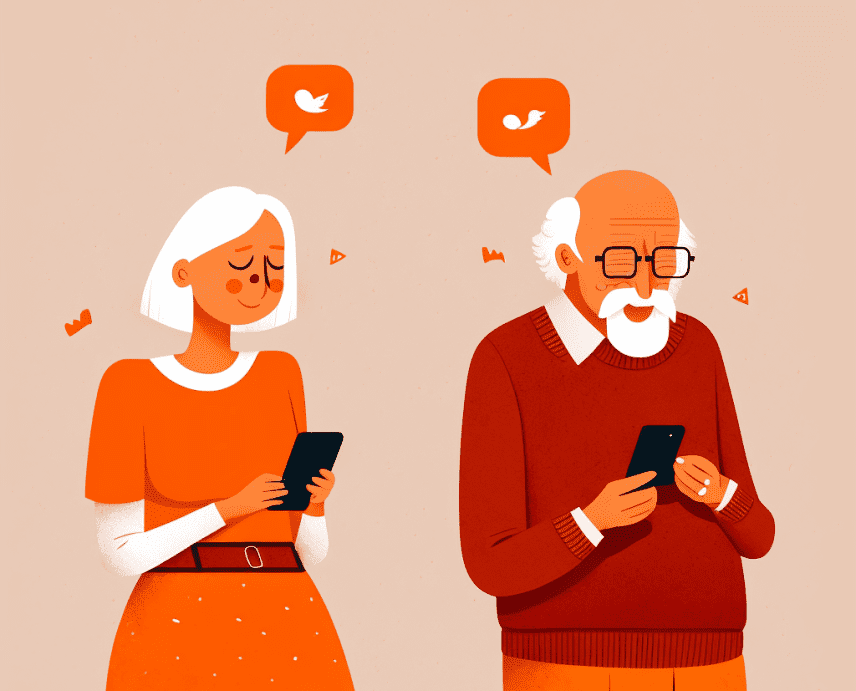Senior Dating Statistics in 2025

While many people never imagined they’d be dating past the age of 65, whether due to the loss of a partner or other life events, some find themselves looking for love in their golden years.
According to the Pew Research Center, roughly one-third of adults in the United States reported being single in 2022, a number that increases with age.
These statistics paint a more complete picture of the condition of senior dating in 2025 to illustrate its prevalence, demographics, and other factors, such as the frequency of senior isolation and the effects it may have moving forward.
Are Seniors Actively Dating?
As of 2022, 36 percent of people aged 65 and older report being single, a ratio that’s only exceeded by people aged 18 to 29, 41 percent of whom report being single. Interestingly enough, many of these older singles report not actively looking for a committed romantic relationship, and compared to men, women aged 65 and older are nearly twice as likely to be single.
The picture of dating among older adults is complex and varied; however, across the board, we can see a number of trends that indicate many seniors are comfortable living alone. Consider these statistics to get a more detailed picture of senior dating in the United States:
Statistics on Senior Dating
- 36 percent of adults aged 65 and older report being single, compared to 29 percent of people aged 50 to 64, and 21 percent of adults aged 30 to 49.
- Among people aged 65 and older, 49 percent of women report being single, compared to only 21 percent of men.
- 16 percent of single people aged 65 and older say they’re actively looking for a relationship, compared to 36 percent of adults aged 50 to 64, and 57 percent of adults under 50.
Seniors and Dating Apps
- 26 percent of adults aged 50 and older who are single and looking report using a dating app in the last year, compared to 53 percent of people aged 18 to 49.
- The most commonly used dating apps for seniors aged 65 and over are Match (44 percent) and eHarmony (34 percent).
- 17 percent of adults aged 50 and over report that they’ve never used a dating app.
- Among LGBT seniors, 7 percent report they currently use a dating app, while 22 percent say they used one over a year ago.
- 73 percent of seniors report wanting background checks on dating sites.
Seniors and Sexual Activity
- According to the Healthy Aging Poll, over half of adults aged 65 to 80 who are in a relationship report being sexually active.
- 76 percent of seniors aged 65 to 80 agree that sex is an important part of their relationship.
- While 46 percent of seniors aged 65 to 70 report being sexually active, that number decreases to 25 percent for those 76 and over.
- More senior men report being sexually active than women, at 51 percent compared to 31 percent.
- Seniors who reported their health as “fair” or “poor” were 23 percent less likely to report being sexually active than those who reported their health as “excellent” or “good.”
- Nearly 3 in 4 seniors report being satisfied with their sex life, though women were 8 percent more likely to report this than men.
- Among seniors, 18 percent of men and 3 percent of women take a medication or supplement related to their sexual function.
Seniors and Loneliness
- In 2023, over a third of adults between the ages of 50 and 80 report feeling socially isolated in the preceding year.
- 37 percent of older adults report that they feel a lack of companionship, up from 34 percent before the pandemic.
- Nearly three-quarters (73 percent) of those who reported fair to poor mental health report feeling a lack of companionship (compared to 33 percent of those reporting good mental health).
- 43 percent of seniors with an annual income of less than $60,000 report feelings of loneliness compared to 31 percent of those with larger incomes.
Loneliness in Seniors
In a report from the National Academies of Sciences, Engineering, and Medicine, researchers found that seniors considered to be socially isolated are 1.5 times as likely to be diagnosed with dementia, and around 1.3 times as likely to be diagnosed with heart disease or to suffer a stroke. Additionally, almost 25 percent of seniors over the age of 65 are considered socially isolated, which should raise dramatic concerns about the social condition of seniors in the post-pandemic United States.
Dating isn’t the only way for these seniors to find companionship — often, a simple phone call or visit can effectively stave off feelings of isolation. Yet, dating remains an effective way for seniors to find long-term companionship within their age group, preventing loneliness and the physical and mental effects it can cause.
Preventing Loneliness
Of course, dating can’t always provide a quick fix to social isolation. Some seniors may not be interested in or able to find companionship in this way. Since the effects of isolation are still important to address, consider these alternative strategies to help a loved one prevent social isolation:
- Senior centers: These organizations offer opportunities for seniors to take classes, attend game and movie nights, join social events, and spend time with people their own age. Search local or national directories to find a senior center in your area.
- Volunteer groups: Many volunteer groups welcome seniors to help those in need, such as AmeriCorps Seniors. These groups provide socialization opportunities for seniors who are still physically capable of giving back to their community.
- Companion care: When seniors aren’t physically capable of socializing outside of their homes, they may require socialization to come to them instead. Organizations such as Visiting Angels provide companions for seniors suffering from social isolation. A companion pet could also work in certain circumstances.
For seniors and those with senior loved ones, dating can still be an important part of life. Even without finding a special someone, dating provides opportunities for socialization and company, which prevent the isolation and loneliness that afflicts so many seniors. If you or your loved one are experiencing feelings of isolation, consider the above information as a starting point for finding social opportunities at any age.


